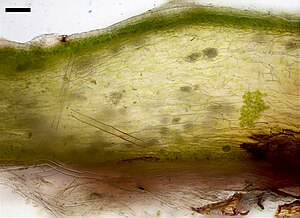Marchantiales
| Marchantiales | |
|---|---|

| |
| Conocephalum conicum - a thallose liverwort | |
| Scientific classification | |
| Kingdom: | |
| Division: | |
| Class: | |
| Order: | Marchantiales Limpr., 1877[1]
|
| Families | |
|
See Classification | |
Marchantiales is an order of thallose liverworts that includes species like Marchantia polymorpha, a widespread plant often found beside rivers, and Lunularia cruciata, a common and often troublesome weed in moist, temperate gardens and greenhouses.
As in other bryophytes, the gametophyte generation is dominant, with the sporophyte existing as a short-lived part of the life cycle, dependent upon the gametophyte.
The genus Marchantia is often used to typify the order, although there are also many species of Asterella and species of the genus Riccia are more numerous. The majority of genera are characterized by the presence of (a) special stalked vertical branches called archegoniophores or carocephala, and (b) sterile cells celled elaters inside the sporangium.
Classification
- Aytoniaceae
- Cleveaceae
- Conocephalaceae
- Corsiniaceae
- Cyathodiaceae
- Exormothecaceae
- Lunulariaceae
- Marchantiaceae
- Monocarpaceae
- Monosoleniaceae
- Oxymitraceae
- Ricciaceae
- Targioniaceae
- Wiesnerellaceae
References
- Crandall-Stotler, Barbara J. & Stotler, Raymond E. "Morphology and classification of the Marchantiophyta". page 63 in A. Jonathan Shaw & Bernard Goffinet (Eds.), Bryophyte Biology. (Cambridge: Cambridge University Press:2000). ISBN 0-521-66097-1.
- Grolle, Riclef (1983). "Nomina generica Hepaticarum; references, types and synonymies". Acta Botanica Fennica 121, 1-62.
External links

